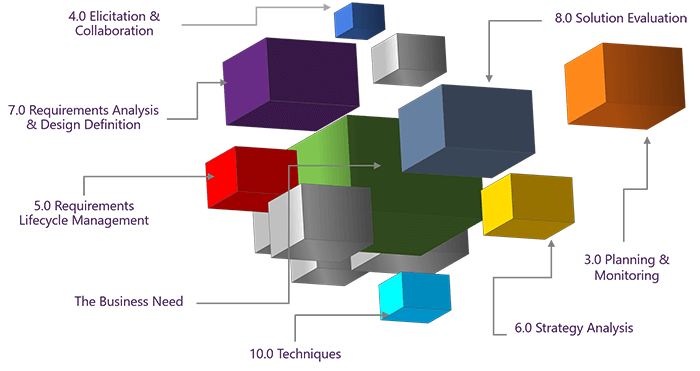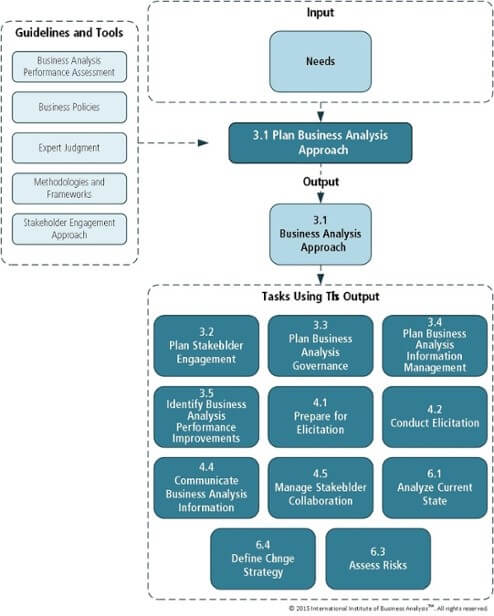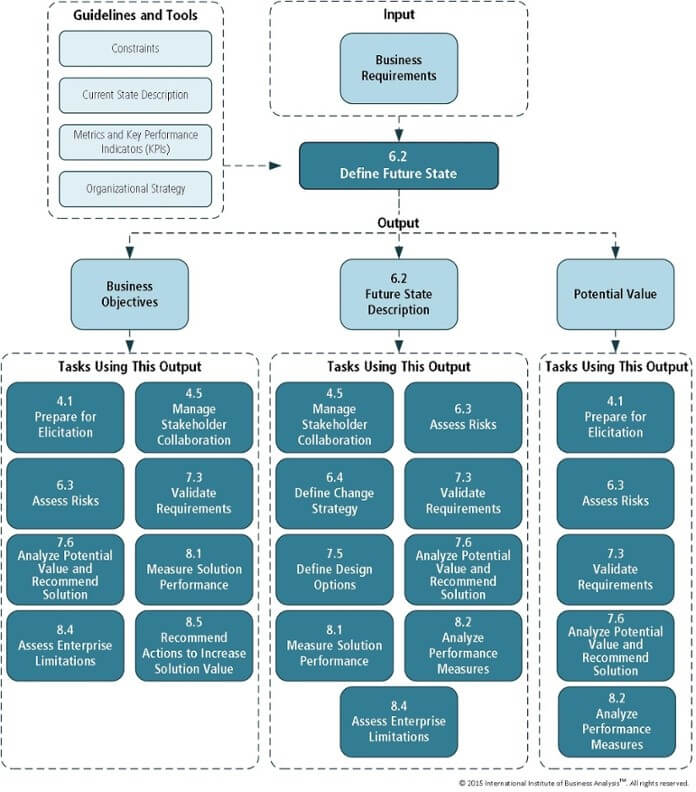
A 3-D View to Understanding the BABOK
As a business analyst practitioner and facilitator, I often find myself cautioning those individuals who are embarking on certification to pay particular attention to 2 key things when studying for either the CCBA Exam or the CBAP Exam.
- Do not read the BABOK from front to back or put another way, do not read it in a linear fashion!
- Rely heavily on your experiences and pragmatic approach to business analysis.
Here is how I start off the conversation with BA Certification candidates;
“If you had to choose a Knowledge Area or Task outlined in the BABOK, which one would you start with?”
As you can imagine responses are wide and varied some respond with Strategy Analysis, others with Elicitation and Collaboration while others are adamat that all business analysis activities must start with Planning and Monitoring.

The truth is ALL business analysis activities must start with a business need. All business needs must consider validity to the business and feasibility.
The sixty four million dollar question now becomes how do we go about doing this?
The answer quite frankly is not an easy one, and this is where the 3-D approach comes into play.
Consider This Business Analysis Exam Study Tip
In order to understand the business need it is likely we are going to want to engage with stakeholders, this means we would need to a. identify stakeholders and b. conduct some sort of elicitation activity to do so. In order o identify stakeholders we may have to undertake some sort of current state analysis by modeling out the organization or developing a context diagram.
And there you have it! To simply understand the business need we have evoked activities from the Planning and Monitoring Knowledge Area, Eliciation and Collaboration, Strategy Analysis and Requirements Analysis and Design Definition, all these activities have collided together for the sake of on task – understanding the business need, and we have yet to begin to understand what the solution may look like, if in fact it is feasible!

CONCLUSION:
For exam preparation I would strongly suggest that you consider reviewing the input and output diagrams as this will paint the 3D story of how knowledge areas and tasks are closely inter-related here’s a classic example.

Note all tasks that use the output from task 3.1 Plan the Business Analsyis Approach

There certainly are a great deal of tasks dependent on the output for task 6.2 Define the future state!
Would you like a copy of a comprehensive map that demonstrates all the relationships between knowledge areas?
Check this Out >>> The New IIBA Business Analysis Core Standard
best online casino
casino streaming online https://download-casino-slots.com/
caesars pa online casino bonus code
casino spiele online spielen https://firstonlinecasino.org/
slots online casino free
online casino paypal withdrawal https://onlinecasinofortunes.com/
caesars palace online casino
online casino apps https://newlasvegascasinos.com/
best online casino to win money
online casino real money california https://trust-online-casino.com/
el royale online casino review
best online casino reddit https://onlinecasinosdirectory.org/
golden nugget online casino nj
jackpotcity online casino https://9lineslotscasino.com/
resort online casino
online live casino https://free-online-casinos.net/
mobile online casino
online casino ideal betaling https://internet-casinos-online.net/
mohegan sun online casino pa
online casino bonus https://cybertimeonlinecasino.com/
online casino usa real money no deposit bonus
how to start an online casino https://1freeslotscasino.com/
online casino stocks
vegas world free online casino games https://vrgamescasino.com/
resorts casino online app
best online casino sites https://casino-online-roulette.com/
casino online free bonus
winstar online social casino https://onlineplayerscasino.com/
gta online casino
online casino blackjack https://ownonlinecasino.com/
rsweeps online casino 777
online casino nj https://all-online-casino-games.com/
nj online casino free money
resort casino online https://casino8online.com/
how to buy a vpn server
business vpn setup https://freevpnconnection.com/
buy a vpn router
good free vpn https://shiva-vpn.com/
best vpn for bbc iplayer
vpn free trial no credit card https://freehostingvpn.com/
japan vpn free
express vpn https://ippowervpn.net/
free vpn for roobet
vpn app https://imfreevpn.net/
free pc vpn
which vpn to buy https://superfreevpn.net/
express vpn
best private vpn https://free-vpn-proxy.com/
hola free vpn proxy
completely free vpn https://rsvpnorthvalley.com/
gay male dating app
gay dating bakersfield https://gay-singles-dating.com/
gay dating sites in nc
gay dating websites for teens https://gayedating.com/
completely free gay dating sites
gay fat dating https://datinggayservices.com/
datng websites
dating sites contact united states https://freephotodating.com/
men dating sites
good dating websites https://onlinedatingbabes.com/
online dating services
plenty fish date site https://adult-singles-online-dating.com/
singles matching
free sites of dating https://adult-classifieds-online-dating.com/
best sites dating
adilt dating https://online-internet-dating.net/
sexy dating
date website free https://speedatingwebsites.com/
lesbian dating apps
searchingforsingles https://datingpersonalsonline.com/
best dating apps
meet singles online https://wowdatingsites.com/
free dating siwomen
asien dating online https://lavaonlinedating.com/
match dating site
casual dating https://freeadultdatingpasses.com/
free single dating sites
datinghotlot https://virtual-online-dating-service.com/
free dating online dating
online dating match https://zonlinedating.com/
best free online dating sites
free site https://onlinedatingservicesecrets.com/
golden nugget online casino michigan
best online casino sites https://onlinecasinos4me.com/
maryland live casino online gambling
golden eagle casino online https://online2casino.com/
rivers casino sportsbook online
drake online casino https://casinosonlinex.com/
chat avenue gay
gay chat roulette chat https://newgaychat.com/
gay chat rooms, san diego
gay group chat https://gaychatcams.net/
gay and bi text chat
gay chat roulette chat https://gaychatspots.com/
gay couple on chat video
gay sex video chat https://gay-live-chat.net/
random gay video chat
free bi gay chat sites seattle wa https://chatcongays.com/
gay connect cam chat
free rulette gay chat https://gayphillychat.com/
free gay chat apps for windows
gay sex chat rooms https://gaychatnorules.com/
random chat gay
gay chat ohio https://gaymusclechatrooms.com/
gay chat roulette
western pa gay chat https://free-gay-sex-chat.com/
gay sissie video chat
gay chat 877-***-7000 https://gayinteracialchat.com/
gay chat chartestone
popular gay chat site https://gaymanchatrooms.com/
pay someone to write a paper
buy cheap paper online https://term-paper-help.org/
help me write my paper
buy custom papers https://sociologypapershelp.com/
paper writing help online
what should i write my paper on https://paperwritinghq.com/
writing paper help
website that will write a paper for you https://write-my-paper-for-me.org/
paper help writing
buy cheap papers https://doyourpapersonline.com/
cheap paper writing services
write my paper for cheap https://top100custompapernapkins.com/
paying someone to write a paper
help with writing a paper https://researchpaperswriting.org/
write my paper cheap
what should i write my paper on https://cheapcustompaper.org/
write my statistics paper
custom paper writers https://writingpaperservice.net/
best paper writing service
college papers for sale https://buyessaypaperz.com/
need someone write my paper
ghost writer for college papers https://mypaperwritinghelp.com/
do my college paper for me
pay for someone to write your paper https://writemypaperquick.com/
paper writing services online
ghost writer college papers https://essaybuypaper.com/
pay someone to do my paper
best online paper writers https://papercranewritingservices.com/
website that will write a paper for you
buying college papers online https://ypaywallpapers.com/
white paper writing services
pay for paper https://studentpaperhelp.com/
2benefit
1legitimate
degree coursework
do my coursework https://brainycoursework.com/
coursework moderation
creative writing coursework ideas https://courseworkninja.com/
coursework marking
degree coursework https://writingacoursework.com/
cpa coursework
coursework writer uk https://mycourseworkhelp.net/
online coursework
coursework sample https://courseworkdownloads.com/
coursework
coursework masters https://courseworkinfotest.com/
coursework only degree
coursework marking https://coursework-expert.com/
coursework research
do my coursework online https://courseworkdomau.com/
international dating
local free dating sites https://freewebdating.net/
international dating site reddit
free online dating site https://jewish-dating-online.net/
positive single
free women https://free-dating-sites-free-personals.com/
totally free dating site
dating apps https://sexanddatingonline.com/
lesbian cowgirls
online dating ukraine https://onlinedatingsurvey.com/
dating site for
dating free site https://onlinedatingsuccessguide.com/
dating singles
meet single women online https://onlinedatinghunks.com/
online dating meet
dating chat site https://datingwebsiteshopper.com/
best sites dating
single women dating https://allaboutdatingsites.com/
connect singles
best web dating site https://freedatinglive.com/
best free dating site
free dating websites https://freewebdating.net/